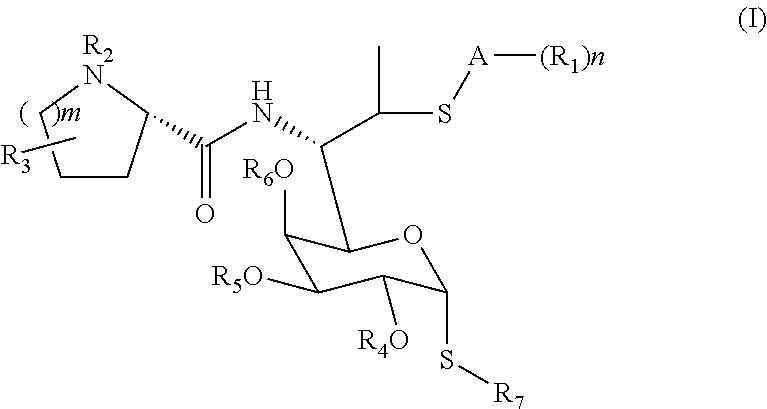Lincomycin derivatives and antimicrobial agents comprising the same as active ingredient
a technology of lincomycin and active ingredient, applied in the direction of antibacterial agents, biocide, organic chemistry, etc., can solve the problems of ineffectiveness of the compounds described in these documents, resistance pneumococci resistance, etc., and achieve the effect of potent antimicrobial activity
- Summary
- Abstract
- Description
- Claims
- Application Information
AI Technical Summary
Benefits of technology
Problems solved by technology
Method used
Image
Examples
reference example 1
5-Phenyl-1,3,4-thiadiazole-2-thiol
[0536]Phosphorus oxychloride (7 ml) was added to 3.67 g (30 mmol) of benzoic acid and 2.73 g (30 mmol) of thiosemicarbazide, and the mixture was stirred at 80° C. for one hr. The reaction solution was added dropwise to 500 ml of a saturated aqueous sodium hydrogencarbonate solution. The resultant precipitate was collected by filtration and was dried. The dried precipitate was suspended in 20 ml of acetonitrile. Cupric chloride (6 g, 45 mmol) and 5.3 g (45 mmol) of tert-butyl nitrite were added to the suspension, and the mixture was stirred at room temperature for 3 hr. The solvent was removed by distillation. Ethyl acetate (100 ml) was added to the residue, and the mixture was washed with 30 ml of 1 N hydrochloric acid and 50 ml of distilled water in that order. The solvent was removed by distillation. The residue was dissolved in 20 ml of ethanol, 3.4 g (45 mmol) of thiourea was added to the solution, and the mixture was heated under reflux for 3 h...
reference example 2
5-(2-Nitrophenyl)-1,3,4-thiadiazole-2-thiol
[0552]Carbon bisulfide (4 ml) was added to a solution of 1.81 g (10 mmol) of 2-nitrobenzohydrazide in 8 ml of methanol. A solution of 616 mg (11 mmol) of potassium hydroxide in methanol (10 ml) was added thereto, and the mixture was stirred at room temperature for 6 hr. The precipitated crystal was collected by filtration and was dried. The dried crystal was added dropwise to 5 ml of concentrated sulfuric acid, and the mixture was stirred at room temperature for 3 hr. The reaction solution was added dropwise to 100 ml of ice water, and the resultant precipitate was collected by filtration and was dried to give 1.21 g (51%) of the title compound.
[0553]The following compounds were synthesized in the same manner as in Reference Example 2 and were used in the Examples.[0554]5-(2-Nitrophenyl)-1,3,4-thiadiazole-2-thiol,[0555]5-(3-nitrophenyl)-1,3,4-thiadiazole-2-thiol,[0556]5-(4-nitrophenyl)-1,3,4-thiadiazole-2-thiol,[0557]5-(2-chlorophenyl)-1,3,...
reference example 3
2-(4,5-Dimethoxy-2-nitrophenyl)-5-methylthio-1,3,4-thiadiazole
[0587]Potassium carbonate (13.8 mg, 1.0 mmol) and 0.0624 ml (1.0 mmol) of methyl iodide were added to a solution of 150 mg (0.510 mmol) of 5-(4,5-dimethoxy-2-nitrophenyl)-1,3,4-thiadiazole-2-thiol produced in Reference Example 2 in N,N-dimethylformamide (2 ml), and the mixture was stirred at room temperature for 10 min. The mixture was diluted with 30 ml of ethyl acetate, and the diluted solution was washed with 30 ml of a 10% aqueous ammonium chloride solution and 30 ml of saturated brine. The organic layer was dried over anhydrous sodium sulfate and was then filtered. The filtrate was concentrated under the reduced pressure, and the resultant crystal was washed with diisopropyl ether to give 140 mg (yield 89%) of the title compound.
[0588]1H-NMR (400 MHz, CDCl3) δ: 2.85 (3H, s), 3.99 (3H, s), 4.02 (3H, s), 7.17 (1H, s), 7.66 (1H, s).
[0589]MS (FAB+) m / z: 314 (M++1).
PUM
| Property | Measurement | Unit |
|---|---|---|
| weight | aaaaa | aaaaa |
| temperature | aaaaa | aaaaa |
| temperature | aaaaa | aaaaa |
Abstract
Description
Claims
Application Information
 Login to View More
Login to View More - R&D
- Intellectual Property
- Life Sciences
- Materials
- Tech Scout
- Unparalleled Data Quality
- Higher Quality Content
- 60% Fewer Hallucinations
Browse by: Latest US Patents, China's latest patents, Technical Efficacy Thesaurus, Application Domain, Technology Topic, Popular Technical Reports.
© 2025 PatSnap. All rights reserved.Legal|Privacy policy|Modern Slavery Act Transparency Statement|Sitemap|About US| Contact US: help@patsnap.com



